
Leptospermum scoparium, commonly called mānuka, manuka, manuka myrtle, New Zealand teatree, broom tea-tree, or just tea tree, is a species of flowering plant in the myrtle family Myrtaceae, native to south-east Australia and New Zealand.

Myrtaceae or the myrtle family is a family of dicotyledonous plants placed within the order Myrtales. Myrtle, pohutukawa, bay rum tree, clove, guava, acca (feijoa), allspice, and eucalyptus are some notable members of this group. All species are woody, contain essential oils, and have flower parts in multiples of four or five. The leaves are evergreen, alternate to mostly opposite, simple, and usually entire. The flowers have a base number of five petals, though in several genera the petals are minute or absent. The stamens are usually very conspicuous, brightly coloured and numerous.
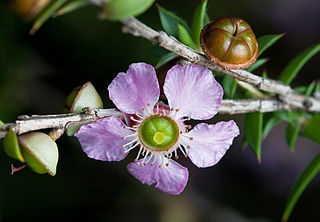
Leptospermum is a genus of shrubs and small trees in the myrtle family Myrtaceae commonly known as tea trees, although this name is sometimes also used for some species of Melaleuca. Most species are endemic to Australia, with the greatest diversity in the south of the continent, but some are native to other parts of the world, including New Zealand and Southeast Asia. Leptospermums all have five conspicuous petals and five groups of stamens which alternate with the petals. There is a single style in the centre of the flower and the fruit is a woody capsule.

The Tortricidae are a family of moths, commonly known as tortrix moths or leafroller moths, in the order Lepidoptera. This large family has over 10,350 species described, and is the sole member of the superfamily Tortricoidea, although the genus Heliocosma is sometimes placed within this superfamily. Many of these are economically important pests. Olethreutidae is a junior synonym. The typical resting posture is with the wings folded back, producing a rather rounded profile.

Kunzea ericoides, commonly known as kānuka, kanuka, white tea-tree or burgan, is a tree or shrub in the myrtle family, Myrtaceae and is endemic to New Zealand. It has white or pink flowers similar to those of Leptospermum and from its first formal description in 1832 until 1983 was known as Leptospermum ericoides. The flowers have five petals and up to 25 stamens which are mostly longer than the petals.

Leptospermum laevigatum, commonly known as the coast tea tree, is a species of shrub or small tree that is endemic to south-eastern Australia, but has been widely introduced in other places where it is often considered to be a weed. It has thin, rough bark on the older stems, narrow egg-shaped leaves, relatively large white flowers and flat topped fruit that is shed shortly after reaching maturity.

Leptospermum petersonii, commonly known as lemon-scented teatree, is a species of shrub or small tree that is endemic to eastern Australia. It has thin, fibrous or flaky bark, often strongly-scented elliptic to lance-shaped leaves, white flowers and fruit that are retained for several years. It is commonly grown as an ornamental and is regarded as a minor environmental weed in some areas.

Leptospermum squarrosum, commonly known as the peach blossom tea-tree, is an upright shrub of the family Myrtaceae and is endemic to central eastern New South Wales. It has thin, firm bark, broadly lance-shaped to elliptical leaves, relatively large white or pink flowers and fruit that remain on the plant when mature.

Leptospermum lanigerum, commonly known as the woolly teatree, is a small tree or medium shrub from the plant family Myrtaceae. Its common name derives from the conspicuously hairy capsules produced as fruit, along with the fine, silky hairs present on branches and leaves. L. lanigerum is widespread in many habitats, particularly in waterlogged areas such as moist, sandy coastal heaths, on river banks, riparian scrub, woodlands and on the fringe of montane grasslands. This species is endemic to Australia, with native populations occurring in New South Wales, South Australia, Tasmania and Victoria.
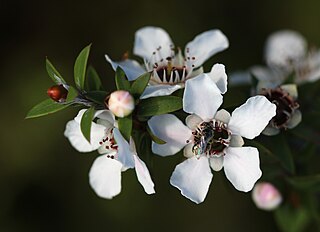
Mānuka honey is a monofloral honey produced from the nectar of the mānuka tree, Leptospermum scoparium. There is no conclusive evidence of medicinal or dietary value in using mānuka honey other than as a sweetener. The word mānuka is the Māori name of the tree; the spelling manuka is common in English.

Leptospermum trinervium, commonly known as flaky-barked tea-tree, slender tea-tree or paperbark tree, is a species of shrub or small tree that is endemic to eastern Australia. It has papery bark that is shed in thin, flaking layers, narrow elliptic to broadly egg-shaped leaves with the narrower at the base, white flowers and silky-hairy fruit that falls from the plant when mature.

Leptospermum nitidum, commonly known as shiny tea-tree, is a species of compact shrub that is endemic to Tasmania. It has crowded, aromatic, elliptical leaves, white flowers about 15 mm (0.59 in) in diameter and fruit that remain on the plants until it is burned or dies.

Leptospermum continentale, commonly known as prickly tea-tree, is species of slender, straggling shrub that is endemic to south-eastern Australia. It has sharp-pointed, narrowly egg-shaped leaves, white flowers arranged singly in leaf axils and woody fruit that remains on the plant when mature.
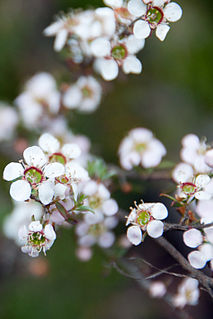
Leptospermum myrsinoides, commonly known as the heath tea-tree or silky tea-tree, is a species of shrub that is endemic to south-eastern continental Australia. It has smooth bark on the younger stems, narrow egg-shaped leaves with the narrower end towards the base, white flowers and fruit that has the remains of the sepals attached but usually falls from the plant soon after the seeds are released.
Brumby Point is a peak on the remote Nunniong Plateau in the Alpine National Park in Victoria, Australia. Distinct from the similarly named Brumby Hill to the north-west, it is bounded by Reedy Creek Chasm to the north and Little Reedy Creek to the south. The locality has been noted for visible folds in the Ordovician rock. A number of rare plant species occur in the area including Eucalyptus elaeophloia and Leptospermum jingera. The "brumby mallee-gum", recently discovered in this location, was formally described in 2013 and assigned the name Eucalyptus phoenix. The seven kilometre long Brumby Point four wheel drive track which traversed the ridge leading up to the point was earmarked for permanent closure in 1992.

Leptospermum polygalifolium, commonly known as tantoon, jellybush or yellow tea tree, is a species of shrub or tree of the family Myrtaceae that is endemic to eastern Australia, including Lord Howe Island. It has thin bark, elliptical leaves, white flowers arranged singly on short side shoots and fruit that remain on the plant for a few years.

Leptospermum rupestre, commonly known as alpine tea-tree or prostrate tea-tree, is a flowering shrub in the myrtle family, Myrtaceae. It is endemic to Tasmania. In alpine areas it assumes a prostrate habit while in subalpine areas it appears as a large shrub.
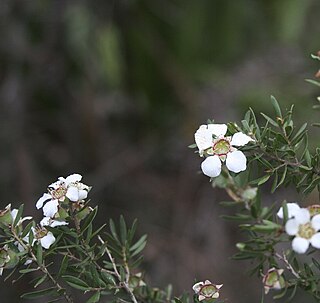
Leptospermum juniperinum, commonly known as the prickly tea tree, is a species of broom-like shrub that is endemic to eastern Australia. It has narrow, sharply pointed leaves, white flowers usually arranged singly on short side shoots and small fruit that remain on the plant when mature.
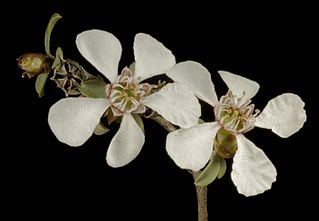
Leptospermum erubescens, commonly known as the roadside tea tree, is a species of shrub that is endemic to southwest of Western Australia. It has thin, fibrous bark, egg-shaped leaves, small white flowers and woody fruit.
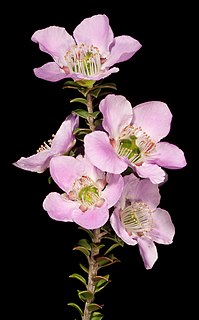
Leptospermum rotundifolium, commonly known as the round-leaved tea tree, is a member of the family Myrtaceae endemic to New South Wales and is now naturalised in a small area of Western Australia.


















